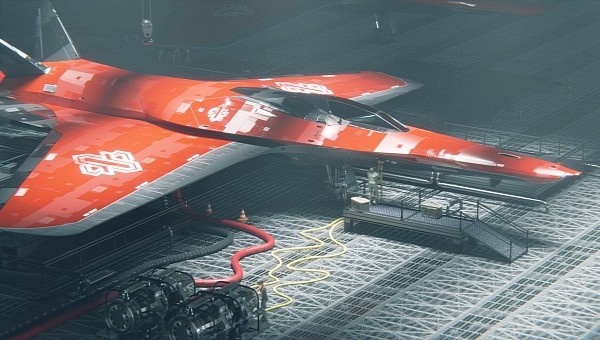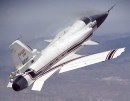Even for hardcore avionics fans, the name ISS-900 Lyda Interceptor might not ring any bells or alarms for a valid reason. The designation belongs to a futuristic (read digital) concept of a military airplane, courtesy of Dutch CGI illustrator Bert Willemsen.
His design is a far-fallen apple from the proverbial mainstream aviation tree. The somewhat challenging engineering proposals, like the rear-swept delta wing and lack of visible air inlets, raise some questions. Assuming the artist sticks to the traditional propulsion systems of today, that is, and conceived some form of air-bound flying machine.
Should the contrary be correct – as the name might recommend – the virtual creation could be a space plane. ISS would stand for International Space Station or some other shade of space-related military authority in this case. Why military? Because the "interceptor" designation doesn't leave much room for argument or debate – that's one explicit aspect of the Netherland-imagined war bird. What is not so clear is what it ought to intercept.
A closer look might suggest a far-fetched future fate for the fighting ISS-900 Lyda. The retractable landing gear legs hold plates instead of the usual rolling tire-on-wheel assembly. This leads us to fantasize about vertical take-off and landing - and perhaps rocket propulsion instead of air-fed combustion jets.
The aircraft's geometry is rather intriguing and contradicts the space-based hypothesis, with the massive, inverted delta wings protruding outwards. The giant lifting surfaces are crucial in atmospheric flight. Outer space does not bow to aerodynamic laws simply because there is no air to constrain flight. Or sustain it, depending on your perspective on the above-ground motion.
In full disclosure, the reverse-swept wing is not ground-breaking. It is air-braking: the design proved successful with NASA's pair of Grumman X-29 prototypes and the Russian Sukhoi Su-47 tech demonstrator. The two airplanes look confusingly similar in design (compare them in the gallery). Perhaps not coincidentally - the American variant might have "inspired" the Soviet testbed.
Furthermore, the aft strakes trailing the wing sweep towards the twin vertical stabilizers also pay homage to air-flying machines. The elongated front section of the fuselage reminds me of speedboats. The contradictions continue with the bright orange and metallic grey livery patterned with a seemingly inexplainable quadruple row of transverse lines in a lighter shade than the rest.
The artist preferred keeping the engine details under the critics' radar and gave us no visual perspective. Still, the bulky rear half of the aerospace craft is not in line with today's military fighters and interceptors. If we were to let our imaginations run wild – and we are! – we would advocate one of two possibilities. Either two overlaid engines or a massive thruster with an equally voluminous fuel tank. If any other option is available, throw it in the comments section.
Should the contrary be correct – as the name might recommend – the virtual creation could be a space plane. ISS would stand for International Space Station or some other shade of space-related military authority in this case. Why military? Because the "interceptor" designation doesn't leave much room for argument or debate – that's one explicit aspect of the Netherland-imagined war bird. What is not so clear is what it ought to intercept.
A closer look might suggest a far-fetched future fate for the fighting ISS-900 Lyda. The retractable landing gear legs hold plates instead of the usual rolling tire-on-wheel assembly. This leads us to fantasize about vertical take-off and landing - and perhaps rocket propulsion instead of air-fed combustion jets.
The aircraft's geometry is rather intriguing and contradicts the space-based hypothesis, with the massive, inverted delta wings protruding outwards. The giant lifting surfaces are crucial in atmospheric flight. Outer space does not bow to aerodynamic laws simply because there is no air to constrain flight. Or sustain it, depending on your perspective on the above-ground motion.
In full disclosure, the reverse-swept wing is not ground-breaking. It is air-braking: the design proved successful with NASA's pair of Grumman X-29 prototypes and the Russian Sukhoi Su-47 tech demonstrator. The two airplanes look confusingly similar in design (compare them in the gallery). Perhaps not coincidentally - the American variant might have "inspired" the Soviet testbed.
Furthermore, the aft strakes trailing the wing sweep towards the twin vertical stabilizers also pay homage to air-flying machines. The elongated front section of the fuselage reminds me of speedboats. The contradictions continue with the bright orange and metallic grey livery patterned with a seemingly inexplainable quadruple row of transverse lines in a lighter shade than the rest.
The artist preferred keeping the engine details under the critics' radar and gave us no visual perspective. Still, the bulky rear half of the aerospace craft is not in line with today's military fighters and interceptors. If we were to let our imaginations run wild – and we are! – we would advocate one of two possibilities. Either two overlaid engines or a massive thruster with an equally voluminous fuel tank. If any other option is available, throw it in the comments section.










